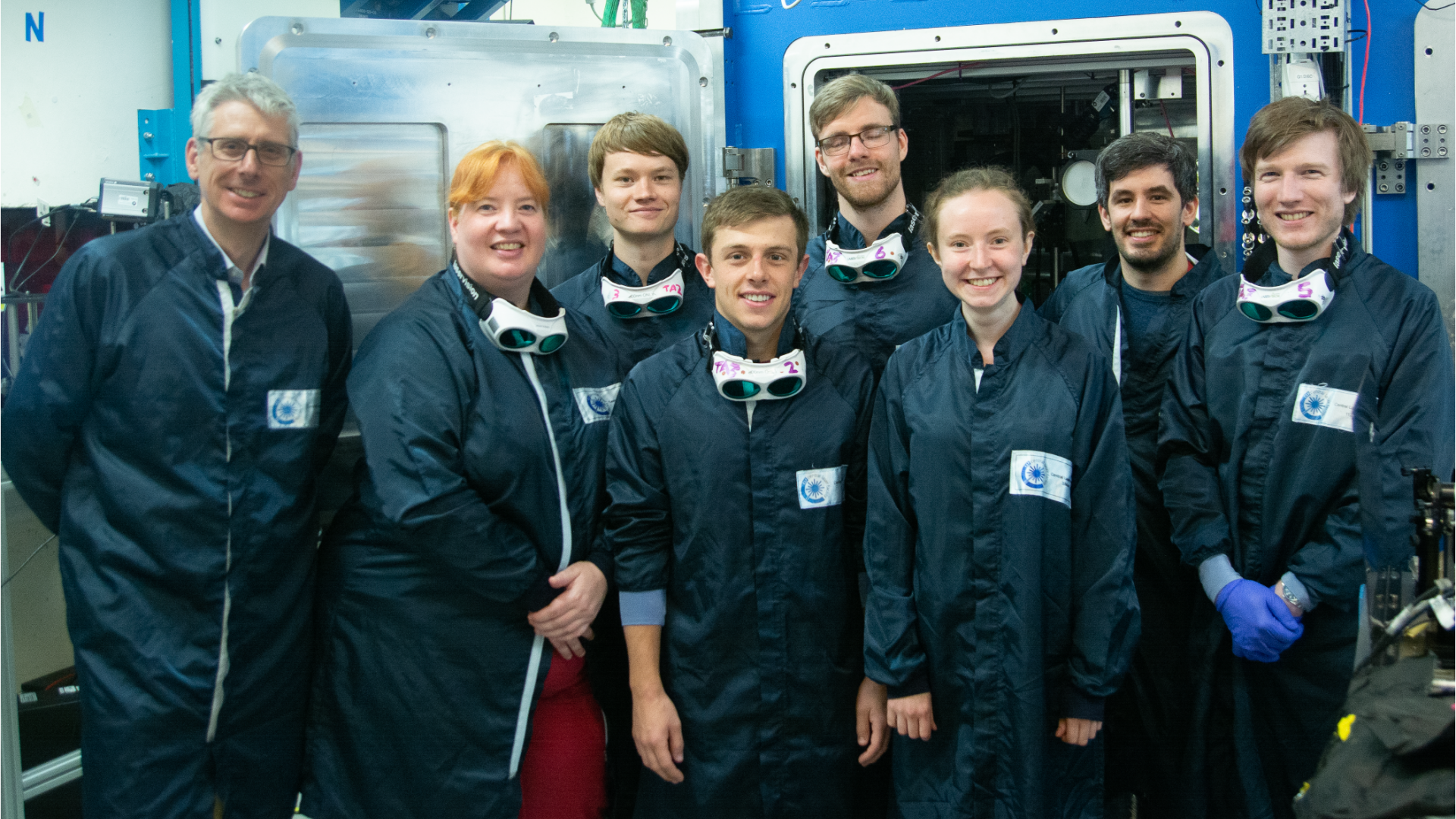Introduction
Our lead academics are all members of the John Adams Institute (JAI), working in Oxford's sub-departments of Particle Physics and in Atomic & Laser Physics. We collaborate closely with JAI at Imperial College and with groups in Europe and the USA. Our experiments are undertaken in the new Oxford Plasma Acclerator Laboratory (OPAL), at facilities based at the Rutherford Appleton Laboratory (just outside Oxford), or with our collaborators in the USA and Europe.
Our work on laser-driven plasma accelerators is in four areas: (i) investigation of techniques for controlling the injection of electrons into the plasma wakefield; (ii) development of new techniques for driving plasma accelerators, such as multi-pulse laser wakefield acceleration; (iii) development of techniques for driving the intense driving laser pulse over 100s of mm; and (iv) development of applications of laser-driven plasma accelerators, particularly their application to the generation of x-rays. We pursue these goals by both experiment and numerical modelling.

Some members of the group, together with a team from University of Liverpool, in the target area of the Astra-Gemini laser at Rutherford Appleton Laboratory
Projects available to start in 2026
A complete list of projects available to start in October 2026 will soon be available in the Laser-Plasma Accelerators section of ALP's D. Phil Projects page (at present the projects listed are last year's; this list will be updated soon)
How to apply
Theoretical and experimental work on plasma accelerators in Oxford is undertaken by a collaboration of research groups in the sub-departments of Particle Physics (particularly within the John Adams Institute for Accelerator Science) and Atomic & Laser Physics. For this reason, applications to work in this area should be made to the sub-departments of Atomic & Laser physics AND to Particle Physics. Further information about research projects available in Atomic & Laser Physics and in the John Adams Institute is available on the ALP and JAI web pages.
Please note that applicants are considered several times per year in “gathered fields”; most applicants are considered in the January gathered field, so you apply for that deadline unless you are unable to do so.
Please be aware that much of the funding we have available to support graduate students is aimed at supporting UK and EU students. However, some scholarships are available for candidates from further afield. You can find details on the university's graduate admissions pages.
Further reading
Plasma-modulated plasma accelerators (P-MoPAs)
- A. J. Ross et al., "Resonant excitation of plasma waves in a plasma channel," Phys. Rev. Res. 6 L022001 (2024). DOI: 10.1103/physrevresearch.6.l022001
- J. J. van de Wetering, S. M. Hooker, and R. Walczak, "Stability of the modulator in a plasma-modulated plasma accelerator," Phys. Rev. E 108 015204 (2023). DOI: 10.1103/physreve.108.015204
- J. J. van de Wetering, S. M. Hooker, and R. Walczak, "Multi-GeV wakefield acceleration in a plasma-modulated plasma accelerator," Phys. Rev. E 109 025206 (2024). DOI: 10.1103/PhysRevE.109.025206
- J. Cowley, C. Thornton, C. Arran, R. J. Shalloo, L. Corner, G. Cheung, C. D. Gregory, S. P. D. Mangles, N. H. Matlis, D. R. Symes, R. Walczak, and S. M. Hooker, "Excitation and Control of Plasma Wakefields by Multiple Laser Pulses," Phys. Rev. Lett. 119 044802 (2017). DOI: 10.1103/PhysRevLett.119.044802
- O. Jakobsson, S. M. Hooker, and R. Walczak, "GeV-scale accelerators driven by plasma-modulated pulses from kilohertz lasers," Phys. Rev. Lett. 127 184801 (2021). DOI: 10.1103/PhysRevLett.127.184801
- S. M. Hooker, R. Bartolini, S. P. D. Mangles, A. Tünnermann, L. Corner, J. Limpert, A. Seryi, & R. Walczak, "Multi-Pulse Laser Wakefield Acceleration: A New Route to Efficient, High-Repetition-Rate Plasma Accelerators and High Flux Radiation Sources," J. Phys. B 47 234003 (2014). DOI: 10.1088/0953-4075/47/23/234003
Hydrodynamic optical-field-ionized (HOFI) plasma channels
- A. Alejo, J. Cowley, A. Picksley, R. Walczak, and S.M. Hooker, "Demonstration of kilohertz operation of hydrodynamic optical-field-ionized plasma channels," Phys. Rev. Accel. Beams 25 011301 (2022). DOI: 10.1103/PhysRevAccelBeams.25.011301
- A. Picksley, A. Alejo, R. J. Shalloo, C. Arran, A. von Boetticher, L. Corner, J. A. Holloway, J. Jonnerby, O. Jakobsson, C. Thornton, R. Walczak, and S. M. Hooker, "Meter-scale conditioned hydrodynamic optical-field-ionized plasma channels," Phys. Rev. E 102, 053201 (2020). DOI: 10.1103/PhysRevE.102.053201
- A. Picksley, A. Alejo , J. Cowley, N. Bourgeois, L. Corner, L. Feder, J. Holloway, H. Jones, J. Jonnerby, H. M. Milchberg, L. R. Reid, A. J. Ross ,R. Walczak, and S. M. Hooker, "Guiding of high-intensity laser pulses in 100-mm-long hydrodynamic optical-field-ionized plasma channels," Phys. Rev. Accel. Beams 23 081303 (2020). DOI: 10.1103/PhysRevAccelBeams.23.081303
- R. J. Shalloo, C. Arran, A. Picksley, A. von Boetticher, L. Corner, J. Holloway, G. Hine, J. Jonnerby, H. M. Milchberg, C. Thornton, R. Walczak, and S. M. Hooker, "Low-density hydrodynamic optical-field-ionized plasma channels generated with an axicon lens," Phys. Rev. Accel. Beams 22 041302 (2019). DOI: 10.1103/PhysRevAccelBeams.22.041302
- R. J. Shalloo, C. Arran, L. Corner, J. Holloway, J. Jonnerby, R. Walczak, H. M. Milchberg, and S. M. Hooker, "Hydrodynamic optical-field-ionized plasma channels," Phys. Rev. E 97 053203 (2018). DOI: 10.1103/PhysRevE.97.053203
Controlled electron injection
- J. Chappell et al., "High-brightness, symmetric electron bunch generation in a plasma wakefield accelerator via a radially-polarized plasma photocathode," Phys. Rev. Accel. Beams 28 101301 (2025). DOI: 10.1103/hqqg-7rcd
- A. Picksley et al., "All-Optical GeV Electron Bunch Generation in a Laser-Plasma Accelerator via Truncated-Channel Injection," Phys. Rev. Lett. 131 245001 (2023). DOI: 10.1103/physrevlett.131.245001
- N. Bourgeois, J. Cowley and S. M. Hooker, "Two-Pulse Ionization Injection into Quasilinear Laser Wakefields," Phys. Rev. Lett. 111 155004 (2013). DOI: 10.1103/PhysRevLett.111.155004
Radiation generation
- M. Fuchs, F. Gruner, S. Karsch, S. M. Hooker et al., "Laser-driven soft-X-ray undulator source," Nature Physics 5 826 (2009). http://www.nature.com/nphys/journal/v5/n11/full/nphys1404.html
Other papers
- S. M. Hooker, "Developments in laser-driven plasma accelerators," Nature Photonics 7 775–782 (2013). DOI: 10.1038/nphoton.2013.234
- W. P. Leemans, S. M. Hooker et al., "GeV electron beams from a centimetre-scale accelerator," Nature Physics 2 696 (2006). DOI: 10.1038/nphys418
